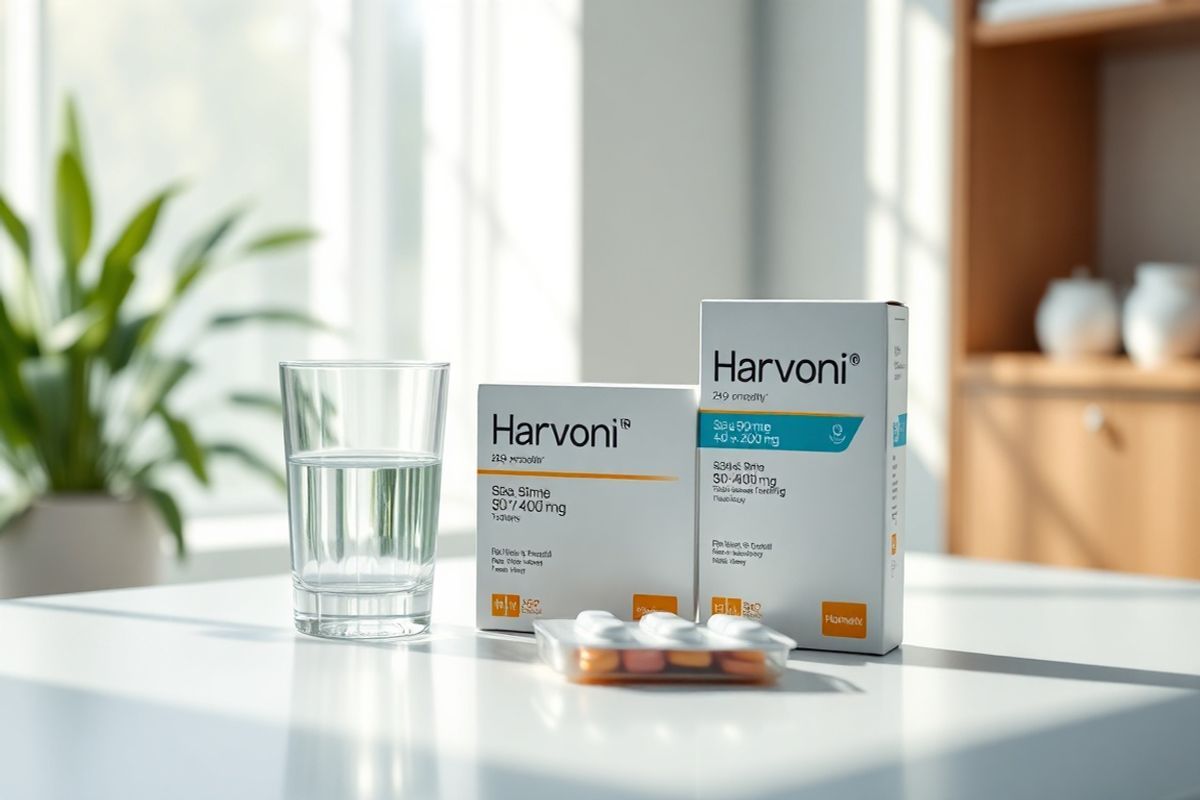Table of Contents
Understanding Harvoni: What It Is and How It Works

Harvoni is a combination medication that contains two direct-acting antiviral agents: ledipasvir and sofosbuvir. Ledipasvir inhibits the hepatitis C virus’s ability to replicate, while sofosbuvir targets the viral polymerase, effectively blocking the virus’s replication process (NIDDK, 2023). This dual action makes Harvoni particularly effective against hepatitis C, specifically genotype 1, which is the most prevalent strain in the United States.
The mechanism of action of Harvoni allows for a rapid reduction in the viral load, leading to a high cure rate. Clinical studies have shown that Harvoni can achieve a sustained virologic response (SVR) in up to 98% of patients after a treatment duration of 12 weeks, making it one of the most effective therapies for hepatitis C on the market (NIDDK, 2023).
Exploring the Different Forms and Strengths of Harvoni

Harvoni is available in tablet form, which can be taken orally. It is offered in two strengths:
- Harvoni 90 mg/400 mg: This formulation contains 90 mg of ledipasvir and 400 mg of sofosbuvir, typically prescribed for adults and children over 12 years of age.
- Harvoni 45 mg/200 mg: This strength is designed for children aged 3 to 11 years, with 45 mg of ledipasvir and 200 mg of sofosbuvir.
Both formulations are designed for once-daily dosing, which enhances patient compliance and convenience (Mayo Clinic, 2023).
TablHarvoni Dosage Forms and Strengths
| Formulation | Ledipasvir (mg) | Sofosbuvir (mg) | Indicated Age Group |
|---|---|---|---|
| Harvoni 90/400 | 90 | 400 | Adults and children >12 |
| Harvoni 45/200 | 45 | 200 | Children 3-11 |
Recommended Dosage Guidelines for Optimal Treatment of Hepatitis C
The recommended dosage of Harvoni depends on the patient’s age, weight, and the severity of liver disease. For most adults, the standard dosage is one tablet of Harvoni 90/400 mg taken once daily, with or without food. Treatment duration typically lasts 8 to 24 weeks, depending on the patient’s previous treatment history and the presence of cirrhosis (Mayo Clinic, 2023).
For pediatric patients aged 3 to 11 years, the dosage is based on weight:
- Children weighing 17 to 25 kg: 45 mg/200 mg once daily.
- Children weighing 26 to 45 kg: 90 mg/400 mg once daily.
It is crucial for patients to adhere to the prescribed dosage regimen to maximize the effectiveness of the treatment (NIDDK, 2023).
TablHarvoni Dosage Guidelines
| Patient Group | Dosage (mg) | Treatment Duration |
|---|---|---|
| Adults | 90/400 once daily | 8-24 weeks |
| Children 3-11 kg | 45/200 once daily | Based on weight |
| Children 26-45 kg | 90/400 once daily | Based on weight |
Practical Tips for Using Harvoni Effectively
To ensure optimal treatment outcomes with Harvoni, patients should consider the following practical tips:
- Consistency: Take Harvoni at the same time each day to maintain a consistent level of medication in the bloodstream.
- Food Considerations: While Harvoni can be taken with or without food, taking it with food may help reduce the risk of gastrointestinal side effects (Cleveland Clinic, 2023).
- Avoid Certain Medications: Inform your healthcare provider about all medications you are taking, as some drugs can interact with Harvoni and reduce its effectiveness, such as antacids, H2 blockers, and certain antibiotics (NIDDK, 2023).
- Regular Monitoring: Regular liver function tests and monitoring for viral load are essential to assess treatment effectiveness and manage any complications (Cleveland Clinic, 2023).
- Stay Hydrated: Adequate hydration can help mitigate some side effects like nausea and fatigue.
Managing Side Effects and Interactions with Harvoni
While Harvoni is generally well-tolerated, patients may experience side effects, which can range from mild to severe. Common side effects include:
- Fatigue: Reported in up to 18% of patients, fatigue may improve as the body adjusts to treatment.
- Headache: Experienced by up to 29% of patients, headaches can be managed with over-the-counter pain relief (Cleveland Clinic, 2023).
- Nausea and Diarrhea: These gastrointestinal side effects are common but often resolve over time.
Serious side effects are rare but may include:
- hepatitis B Reactivation: Patients who are co-infected with hepatitis B may experience reactivation of the virus (Mayo Clinic, 2023).
- Allergic Reactions: Symptoms such as swelling of the face or difficulty breathing require immediate medical attention (CDC, 2023).
TablCommon Side Effects of Harvoni
| Side Effect | Prevalence (%) | Management Strategies |
|---|---|---|
| Fatigue | Up to 18 | Adequate rest and hydration |
| Headache | Up to 29 | Over-the-counter analgesics |
| Nausea | Common | Small, frequent meals and hydration |
| Diarrhea | 3-7 | Increased fluid intake |
FAQs about Harvoni
What should I do if I miss a dose of Harvoni?
If you miss a dose, take it as soon as you remember. If it’s almost time for your next dose, skip the missed dose and return to your regular schedule. Do not take two doses at once.
Can pregnant women take Harvoni?
Harvoni is not recommended during pregnancy. Women of childbearing potential should use effective contraception during treatment and for 6 months after completing therapy.
How long does treatment with Harvoni last?
Treatment duration typically lasts 8 to 24 weeks depending on the patient’s specific circumstances, including liver health and prior treatment history.
Is Harvoni effective against all genotypes of hepatitis C?
Harvoni is primarily effective against hepatitis C genotypes 1, 4, 5, and 6. For other genotypes, different therapies may be recommended.
Can I drink alcohol while taking Harvoni?
It is advisable to avoid alcohol during treatment, as it can increase liver stress and potentially worsen liver function.
References
- Centers for Disease Control and Prevention. (2023). hepatitis C Basics. Retrieved from https://www.cdc.gov/hepatitis-c/about/index.html
- Cleveland Clinic. (2023). Hepatitis C: Symptoms, What It Is, How You Get It, Treatment. Retrieved from https://my.clevelandclinic.org/health/diseases/15664-hepatitis-c
- National Institute of Diabetes and Digestive and Kidney Diseases. (2023). Hepatitis C. Retrieved from https://www.niddk.nih.gov/health-information/liver-disease/viral-hepatitis/hepatitis-c










